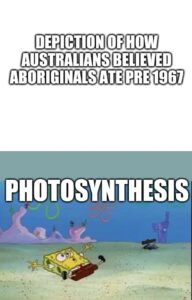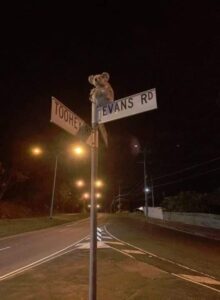Cut and pasted from the ABC web site. – https://www.abc.net.au/news/2018-03-20/fact-check-flora-and-fauna-1967-referendum/9550650
The most comprehensive dismantling of the myth was undertaken by University of Canberra tutor Samuel Byrnand, who devoted an honours project to the topic in 2015.
Mr Byrnand told Fact Check he was compelled to set the record straight because allowing Aboriginal people to believe they were once classified under a flora and fauna act risked perpetuating “transgenerational trauma”.
“There are enough horror stories in Aboriginal Australia; real, actual stories that need to be addressed. We don’t need to be making it up,” he said.
They all said Australia had never had a flora and fauna act that covered Aboriginal people.
Fact Check found that a number of acts existing in Queensland, South Australia, Tasmania, Victoria and WA between 1919 and 1988 had included the word “fauna”. However, none of these involved Aboriginal people.
The 1967 referendum paved the way for amendments to the Australian constitution that allowed greater Commonwealth involvement in Aboriginal affairs, but it also held symbolic significance.
Experts consulted by Fact Check were unanimous in confirming this. Adding their voices to those of Professor Langton, Professor Irving and Mr Byrnand, were James Cook University Adjunct Professor of History Russell McGregor and University of NSW Law Professor Megan Davis.
They all said Australia had never had a flora and fauna act that covered Aboriginal people.
The Western Australian Museum website states that a flora and fauna act that supposedly classed Aboriginal people alongside native Australian flora and fauna never existed, but “the New South Wales National Parks and Wildlife Act 1974 may have encouraged this belief” as it gave the NSW Government control over Aboriginal heritage and landscape.
The website also states that, in 1909, separate authorities responsible for Aboriginal affairs and for fisheries in WA were amalgamated to form the Department of Aborigines and Fisheries (DAF).
In his honours paper, Canberra University’s Mr Byrnand states: “It is understandable that the formation of the DAF might have been misconstrued to mean that Aboriginal people were officially determined to be of equal status to fish or fauna, in WA.”
My Byrnand’s research also refers to a 1929 report of a Royal Commission on the Constitution of the Commonwealth, which includes a chapter heading “Aborigines, Fauna and Flora, Fisheries and Forestry”.
This too, he writes, may have been misconstrued as Aboriginal people coming under the same classification as plants and animals.
But each topic is mentioned separately, with no suggestion of any connection between them.
Professor Davis, the Pro Vice-Chancellor Indigenous at the University of NSW, told Fact Check by email that the Expert Panel on Constitutional Recognition of Indigenous Australians in 2011 had forensically searched for a flora and fauna act, but found nothing.
“No such legislation exists,” she wrote.


Legal changes achieved by the referendum
The referendum of May 27, 1967 approved two amendments to the constitution relating to Indigenous Australians.
Section 51 (xxvi) was altered and section 127 was deleted. More than 90 per cent of the nation and a majority in all states voted yes.
Before the referendum, the Commonwealth could not make special laws for Aboriginal people (except in the territories) because they were governed by state laws.
Removing a reference to Aboriginal people in section 51 (xxvi) meant the Commonwealth gained the power to make special laws for Aboriginal people.
Constitutional law expert Professor Anne Twomey, in a 2017 opinion article in The Australian, cited native title laws as an example of this.
Meanwhile, section 127 of the constitution had excluded Aboriginal people from being counted for constitutional purposes; they were not included in the populations of states and territories for the purposes of allocating federal seats in Parliament.
Nor were they counted for the purposes of calculating certain Commonwealth grants. The removal of section 127 allowed Aboriginal people to be counted for these purposes.
Professor Twomey noted that this did not prevent Aboriginal people from being counted for other purposes — they were counted in the first Commonwealth census in 1911 (except in remote areas).
Also, by 1967, Indigenous Australians were already able to vote in federal and state elections.
He told Fact Check the referendum is popularly remembered as the moment when Aboriginal people won equal rights, even though that was not its legal outcome.
“Amongst some Aboriginal people it’s a pervasive myth and it’s one that is hard to shake because, although empirically it’s false, it embodies elements of a deeper truth about discrimination,” he said.
“They were discriminated against in other ways, not by being part of the flora and fauna act.”
(( Isn’t that interesting, what they didn’t say, indigenous people could then get the pension and that was great however in 1971 the world switched over to a fiat currency and in ’75 the government became a corporation – And everybody got shafted, except the banks.), bank tellers got shafted when ATMs came into use but not the banks. Banks accumulated so much currency they could do what ever they wanted, hence the ’80s and 2008 GFC )
When the Constitution first came into being in 1901 there were only two parts that referred to the First Peoples of Australia: Section 51 (xxvi) gave the Commonwealth power to make laws with respect to ‘people of any race, other than the Aboriginal race in any state, for whom it was deemed necessary to make special laws’; and Section 127 provided that ‘in reckoning the numbers of people of the Commonwealth, or of a State or other part of the Commonwealth, aboriginal natives shall not be counted’.
(“SPECIAL LAWS” !)
Keeping in mind –
word-forming element meaning “away, from, from off, down,” denoting disjunction, separation, departure; from Latin ab (prep.) “off, away from” in reference to space or distance, also of time, from PIE root *apo- “off, away” (also the source of Greek apo “off, away from, from,” Sanskrit apa “away from,” Gothic af, English of, off; see apo-).
The Latin word also denoted “agency by; source, origin; relation to, in consequence of.” Since classical times usually reduced to a- before -m-, -p-, or -v-; typically abs- before -c-, -q-, or -t-.
One has a dig around for older Acts that may have influenced other pieces of legislation, we find the following : https://www.legislation.gov.uk/ukpga/Vict/35-36/15
https://en.wikipedia.org/wiki/Parks_Regulation_Act_1872
https://en.wikipedia.org/wiki/Right_of_way –
Crown land in Australia
Much of Australia’s land area, including most land below the mean high water mark is Crown land, which is administered by the Australian states. Much consists of pastoral leases, land owned and run by Aboriginal people (e.g. APY lands), and “unallocated” Crown land. Access to the latter is normally permitted for recreational purposes, though motorized vehicles are required to follow roads and to be registered and insured.[27]
So, there is something to ponder on.
Be well.
